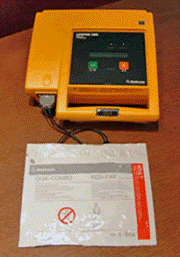What is an AED?

An automated external defibrillator, or AED, is a medical device that automatically analyzes the heart rhythm in cases of cardiopulmonary arrest and, as necessary, guides the operator through voice prompts to treat the subject using its defibrillation function. In Japan, AEDs were approved for use by non-medical professionals in July 2004.
Ventricular fibrillation and defibrillation
Ventricular fibrillation is a medical condition in which cardiac cells make fine and irregular flutters, causing the heart to stop pumping sufficient blood. It is virtually equivalent to a state of cardiac arrest.
Defibrillation is a medical procedure used to treat cardiopulmonary arrest, when an ECG shows signs of ventricular fibrillation or other specific types of arrhythmia. It works by delivering a short, intense burst of electricity to the heart to shock it back into its normal rhythm.
Effectiveness of early defibrillation
Sudden deaths from heart conditions such as myocardial infarction and arrhythmia typically involve a cardiac arrest resulting from ventricular fibrillation or from pulseless ventricular tachycardia. Defibrillation is recognized today as the only and most effective means of returning the heart to its normal rhythm in such circumstances. The timing is crucial, however; in the case of ventricular fibrillation, for example, the subject’s survival rate decreases by 7 to 10% with every passing minute without defibrillation (source: American Heart Association [AHA] 2002 Guidelines).

